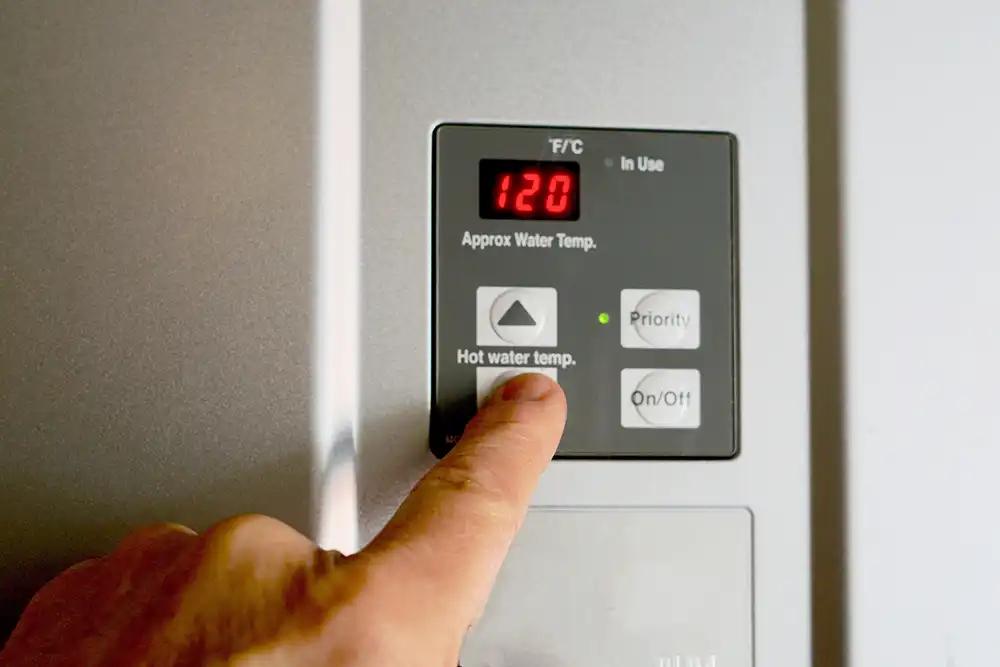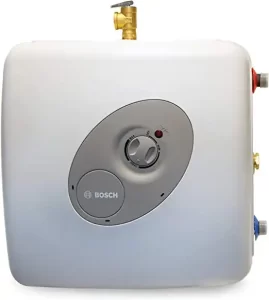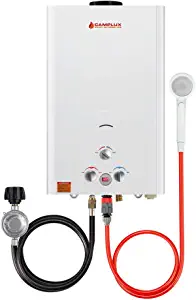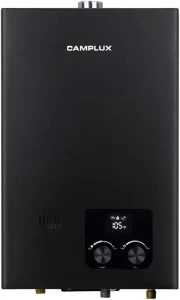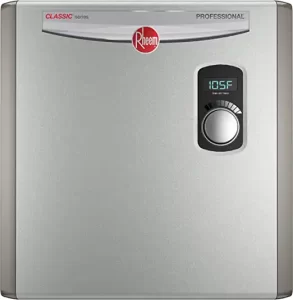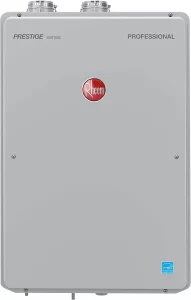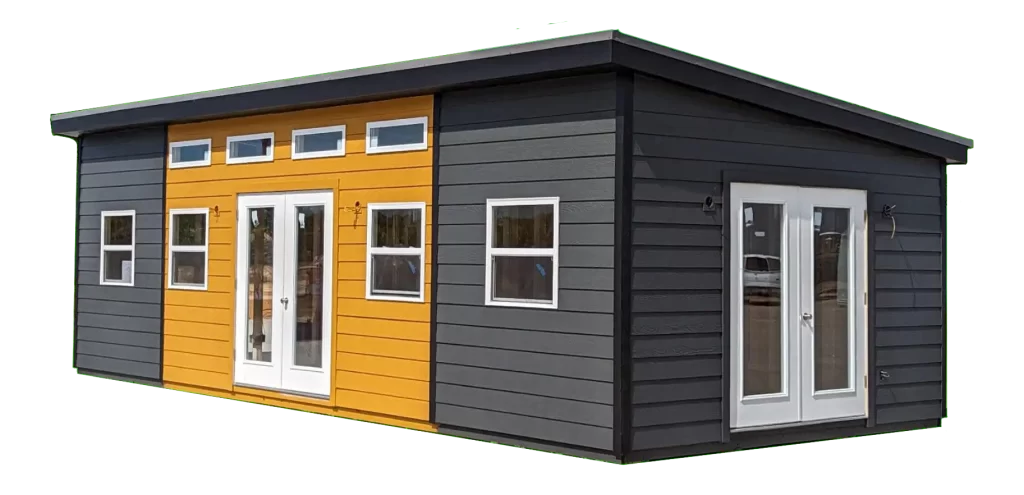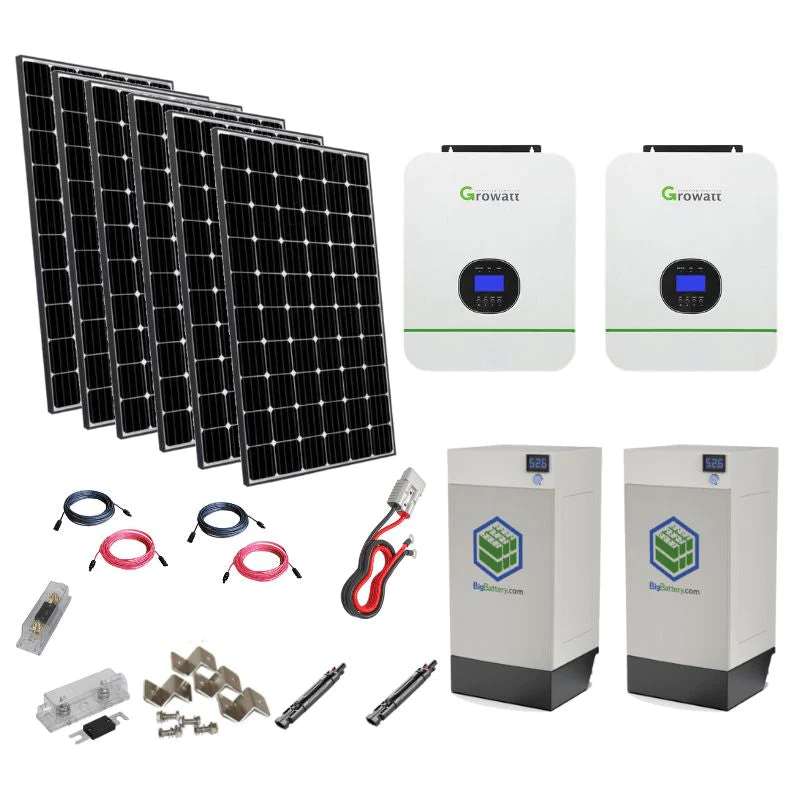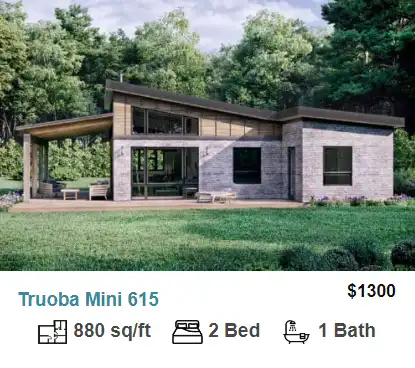Tankless water heaters, also known as instant water heaters and on-demand water heaters, are a natural choice for tiny homes due to their smaller footprint and higher efficiency. But once the decision has been made to go tankless, there are several important questions to ask next. What kind of tankless water heater do I need? What size of tankless water heater is big enough for my tiny home?
The first major consideration to tackle is whether to go gas or electric.
Tankless Gas Water Heaters
As the name implies, gas water heaters burn either propane or natural gas to heat your water. Keep in mind that with the category of gas water heaters, there are condensing and non-condensing units. Non-condensing units run at about 80% and immediately vent the hot gasses from burning out. Condensing water heaters utilize this hot exhaust to increase efficiency to as high as 99%. The higher efficiency of condensing water heaters comes at a higher upfront unit cost.
Let’s take a look at some of the pros and cons of gas water heaters.
Pros:
- Burning gas is a faster and more efficient means of heating water than heating it electrically. Gas burning tankless water heaters consume 50% less power to heat the same amount of water as an electric unit.
- Gas water heaters can be mounted outside in some circumstances. As long as prolonged periods of extremely cold weather are avoided, tankless gas water heaters can be mounted outside with some minimal sheltering considerations.
- Using gas for heating water eliminates a major draw on off-grid electrical systems. This can free up valuable amperage for other appliances.
Cons:
- Tankless gas water heaters require running gas supply and ventilation lines. This makes them more complex to install and maintain.
- Onsite natural gas lines or propane delivery service is required. Those who are way off-grid may have to refill and haul bottles of propane.
- Gas water heaters may have to be modified at higher elevations to account for the decrease in oxygen in the air.
- Fossil fuels are finite and contribute to our carbon footprint. This may be a deal breaker for those looking for sustainable tiny home living.
Tankless Electric Water Heaters
Tankless electric water heaters use electricity, and lots of it, to heat your water. There are a couple of points to consider carefully when selecting an electric tankless water heater. There are many small units on the market that are budget priced and are rated for relatively low amperage. These units are meant to heat water for an individual sink not your entire tiny home. There are also many hybrid units that have a small pre-heated tank to up your hot water output for showering or washing dishes.
Here are some pros and cons of electric water heaters.
Pros:
- Tankless electric water heaters do not require gas or ventilation lines, just electric and water. This allows them to be tucked into some spaces that would not allow adequate venting for a gas unit.
- Tankless electric water heaters can be powered entirely by renewable energy. Although a robust system is required, modern solar batteries can handle the power requirements of tankless water heaters.
- The cost of an electric unit is far less than a gas burning water heater. Tankless gas water heaters can easily cost double that of an equivalent electric unit.
Cons:
- Heating water with electricity requires a massive amperage draw, putting a strain on off-grid systems.
- Heating water with electricity is about 50% less efficient than by burning gas, negating upfront savings in the long run.
- Tankless electric water heaters often require multiple dedicated circuits hardwired to the unit. This will usually necessitate a 200 amp service and subpanel rather than a smaller and cheaper 100 amp box.
Choosing the Right Size Tankless Water Heater
Choosing the right size of tankless water heater depends on two crucial variables. Calculating our desired gallons per minute (GPM) and temperature rise will tell us what size water heater will meet our output requirements. Here is a simple formula for calculating your required GPM at a fixture.
- Fill a 5 gallon bucket at the sink, shower, or tub with the water to set to wide open.
- Divide the number of seconds it took to fill the bucket by five.
- Multiply the quotient by 60.
The result is your required GPM for that fixture. In order to supply hot water to multiple fixtures at once, you will need to add the GPMs of sinks, shower, etc. together.
In order to calculate our required temperature rise, you will need to contact your local water dept. to find out your ground water temperature. Water heaters are generally set to heat water to 120 degrees. So, our required temperature rise will be 120 minus the local ground water temperature. For example, if our local ground water temperature is 50 degrees, our required temperature rise is 70 degrees.
Manufacturers of tankless water heaters publish their units GPM rating at various temperature rises in charts like the one below. Once you have your requirements calculated it is easy to compare them to the charts and determine the right size water heater for your needs.
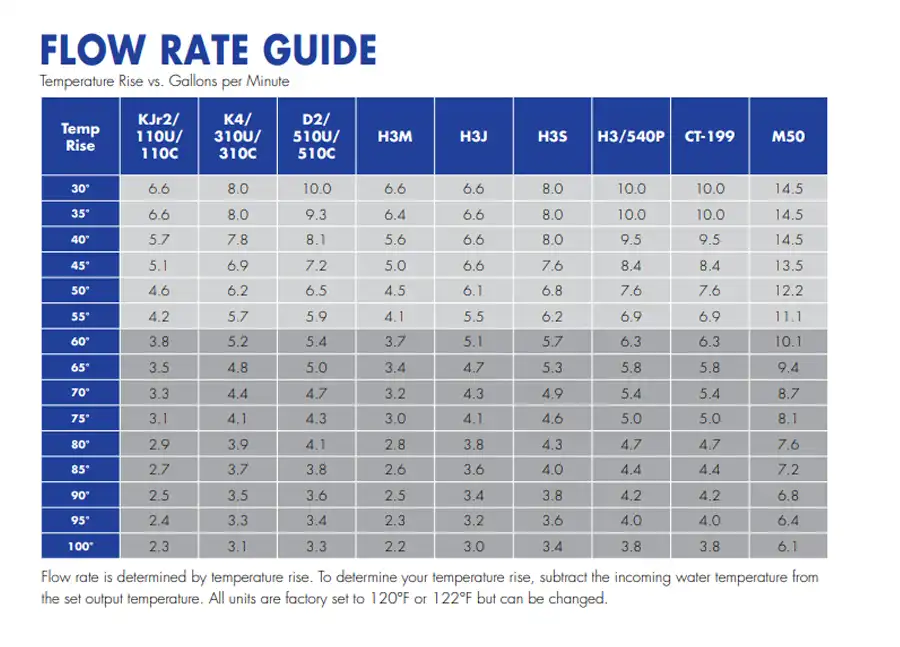
Which Tankless Water Heater to Choose
After installing dozens of both electric and gas tankless water heaters, these are my recommendations for small, medium, and large tiny homes (see the oxymoron there?) in both gas and electric. Those who live in particularly cold regions would be well advised not to choose options from the low-use category.
Best Tankless Electric Water Heater for Low Water Use: Bosch Electric Mini-Tank Water Heater Tronic 3000 T 7-Gallon (ES8)
Ok, so I cheated a little on this one. There just isn’t a pure tankless option that is adequate for bathing in the 15 amp range. This Bosch mini-tank unit gives itself a head start with 7 gallons of pre-heated water. It is super easy to install, only requiring a single dedicated 15 amp circuit.
Best Tankless Gas Water Heater for Low Water Use: Camplux 16L Outdoor 4.22 GPM Digital Display Propane Gas Tankless Water Heater
This is a great unit for small or off-grid tiny homes where climate permits outdoor showering. It is simple to install and take down and store. This unit is for OUTDOOR use only.
Best Tankless Electric Water Heater for Moderate Water Use: Rheem 18kW 240V Tankless Electric Water Heater
This unit from Rheem’s classic series is one of the most straightforward units I have ever installed. It does require two dedicated 40 amp circuits though. As with most tankless electric water heaters, be sure your tiny home has at least a 200 amp service before installing.
Best Tankless Gas Water Heater for Moderate Water Use: Camplux 2.64 GPM Residential Indoor Tankless Water Heater
I can tell you from experience that this little giant is more than capable of keeping up with a hot shower while someone else is using the sink. Installation is relatively easy, but great care must be taken to provide adequate ventilation.
Best Tankless Electric Water Heater for High Water Use: Rheem RTEX-24 24kW 240V Electric Tankless Water Heater
There isn’t really a tiny home scenario that I can think of that would require more power than this 24kW unit from Rheem. In my experience, they have the same bullet-proof reliability as the 18kW Rheem Classics. Keep in mind, this unit requires three dedicated 40 amp breakers for installation.
Best Tankless Gas Water Heater for High Water Use: Rheem Prestige High Efficiency 9.5GPM Indoor Natural Gas Tankless Water Heater
Despite being oversized for most tiny home applications, these 9.5 GPM gas water heaters from Rheem set the bar for real-world efficiency.
So there you have my top picks for water heaters based on what I have learned over six years of building, designing, and selling tiny homes. The two big rules of thumb when choosing a tankless water heater are:
Large tankless electric water heaters require a lot of amperage and multiple dedicated breakers.
Indoor tankless gas water heaters require special attention to ventilation requirements.
Go forward with your knowledge and dare to live tiny!

